|
|
|
Sort Order |
|
|
|
Items / Page
|
|
|
|
|
|
|
| Srl | Item |
| 1 |
ID:
187281


|
|
|
|
|
| Summary/Abstract |
This article analyses how past and contemporary Adivasi voices are expressed in colonial photographs, and how they have—and continue to—both enable and restrict speaking through visual representation. It examines the collection of the German anthropologist Egon von Eickstedt, who in the 1920s took about 12,000 photographic images and 2,000 objects from Adivasi communities in India, Ceylon, and Burma. As a racial anthropologist he defined and framed the photos and created the collection according to his own preconceptions. The photographs, embedded in a colonial context and an increasingly racial/racist German anthropology, reveal very asymmetric power relations. Yet, the voice of the Adivasi is not completely suppressed, as the photographed people are not mere objects, but find various ways of expressing sentiments in the photographs. Ninety years on, the images and objects have lost none of their ambiguity. They continue to resonate when newly arranged and criticized in the permanent exhibition of a German museum, as well as when curated at the Museum of Voice of the Adivasi Academy in Gujarat.
|
|
|
|
|
|
|
|
|
|
|
|
|
|
|
|
| 2 |
ID:
187288
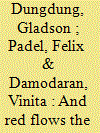

|
|
|
|
|
| Summary/Abstract |
This article documents Adivasi resistance to the ‘loot’ of their land and resources since 1980, especially during the Kalinganagar movement in Odisha, roughly between 2004 and 2010, and the Pathalgadi movement in Jharkhand, between 2016 and 2018. Using the lens of trauma and testimony, the article represents a combined effort by Gladson Dungdung, an Adivasi activist, journalist, and writer who has borne witness to events during these years; Felix Padel, an anthropologist; and Vinita Damodaran, a historian. The land grabs are mainly oriented towards mining and metals production, justified in terms of ‘development’, which leaves many dead and destroys landscapes that Adivasis have cared about for countless generations.
|
|
|
|
|
|
|
|
|
|
|
|
|
|
|
|
| 3 |
ID:
187284


|
|
|
|
|
| Summary/Abstract |
In India, the contested category of Scheduled Tribes (STs) is enacted in order to socially uplift certain indigenous communities. This article concentrates on analysing the intersection between modes of indigenous self-definition, political assertion, and localized conceptualizations of space and belonging. My ethnographic example from the Andaman Islands focuses on the Ranchis, aboriginal labour migrants from the Chotanagpur plateau in central India. Being classified as STs, both in their homelands and other localities to which they migrated, Ranchi activists seek to accomplish coeval recognition in the Andamans. Their demands to be rewarded for the labourers’ contribution to the islands’ development are complicated by their occupation of non-ancestral lands that were originally inhabited by indigenous hunter-gatherer communities. By narrowing the notion of indigeneity, and hence ST status, down to communities who live on ancestral lands and who are culturally, socially, and economically different to migrant communities, state authorities and activists reject the Ranchis’ demands for affirmative action as Adivasis from but not of the Andamans. Reflecting on the existential relationship between land and people in popular understandings of indigenousness, this article aims to investigate the Ranchis’ claims of being migrants, yet also indigenous, in order to explore alternative possibilities to think through the notion of indigeneity. In so doing, I focus on the Ranchis’ subaltern history of racialized labour migration, their lack of voice within the post-colonial welfare regime, and their striving for autonomy and autarky by applying principles of indigenous knowledge and cosmologies from their homelands to the Andamans.
|
|
|
|
|
|
|
|
|
|
|
|
|
|
|
|
| 4 |
ID:
187283
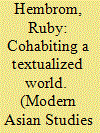

|
|
|
|
|
| Summary/Abstract |
Stories matter—writing them down matters. For indigenous (Adivasi) peoples from oral traditions, literature has become a way to maintain culture and keep it alive. This article too is a story—an investigative one—questioning and vocalizing the challenges we encounter in trying to articulate our realities and histories in a form that is new to us, one that we've been denied as a practice and one we are not believed we are entitled to use. Mainstream cultures have side-lined, overshadowed, and subjugated our knowledge systems, placing us in structures we have to traverse, and within which we have to exist, which is possible only by internalizing and mirroring others' or mainstream ways and languages to gain legitimacy as peoples or, worse, being branded and judged by their versions of narratives of us. This article plots the course of Adivasi histories and narratives enduring, outlasting, or being demolished by dislocation and dispossession, by dominant languages and cultures, and how both writing and orality are practices of both resistance and resurgence.
|
|
|
|
|
|
|
|
|
|
|
|
|
|
|
|
| 5 |
ID:
187286
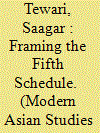

|
|
|
|
|
| Summary/Abstract |
As a means to resolve the Tribal Question in India, the centrality of the Fifth and Sixth Schedules of the Indian Constitution is widely acknowledged. However, their final incorporation, despite intense nationalist opposition in the run-up to Indian Independence, remains historically unexplained. This article addresses this lacuna by reconstructing the circumstances under which the Indian National Congress came to accept scheduling as a viable method of providing protection to tribal communities. This strategic shift can be explained as a result of combined political pressures generated by communist-led tribal movements and a steadily mounting challenge heralded by a new stream of educated middle-class tribal activists in eastern India. Foremost among the latter was Jaipal Singh Munda who mobilized a large constituency of supporters demanding a separate province of Jharkhand. Taken together, there is enough evidence to prove that in the period 1937–1950, the tribes were not silent and their collective agency had a deep impact on the constitution-making process. Finally, the article argues that this period witnessed a significant change in the character of the Congress as erstwhile freedom-fighters turned into ruling elites.
|
|
|
|
|
|
|
|
|
|
|
|
|
|
|
|
| 6 |
ID:
187287
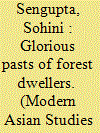

|
|
|
|
|
| Summary/Abstract |
This article discusses the shifts in rights over land of Binjhal Adivasi people in the wake of colonial rule in the ex-zamindari of Borasambar, located in the British Central Provinces in the eventful period from 1860–1926. Oral narratives and documents preserved by Binjhal villagers juxtaposed with archived records of military expeditions, village surveys, administrative letters, and land settlement reports reveal how Binjhal ancestors lost titled land and offices of headmanship, which, over time, impoverished and diminished them in the rural hierarchy. The research finds that the codification of selective custom as legal rights accommodated colonial land policies to promote social change and agricultural improvement. Environmental histories document how nineteenth-century forest enclosures and agrarian order brought Adivasi areas within state control. Revisionist research highlights historically contingent outcomes of colonial rule. The Adivasi pasts in this article reveal how the interpretations of legal culture by local actors, who transacted with the administration, led to variable outcomes for a pre-colonial land-controlling group. By examining the truth claims in fragments of Binjhal voices and narratives about them, in village memories and archives, through a threefold examination of the past—pragmatic, habitual, and episodic—this article explores the historicity of Adivasi land memories. Here, stories of past glory lead to claims of legal entitlements rather than restitution of ancient rule, and injustices are described in the idiom of disrupted kinship and transgressions of women, illuminating the varied routes through which groups residing in relatively non-agrarian upland habitats became Adivasi.
|
|
|
|
|
|
|
|
|
|
|
|
|
|
|
|
| 7 |
ID:
187285
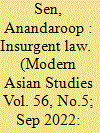

|
|
|
|
|
| Summary/Abstract |
This article studies the adjudicatory practices deployed by colonial military and police forces during a series of punitive British expeditions in the eastern frontiers of British India and the northern reaches of British Burma, specifically the Lushai and Chin Hills in the late nineteenth century. It magnifies the lives, deaths, and afterlives of two ‘tribal’ chiefs of Lushai Hills. Among others, these figures were held responsible for a series of raids carried out in the settled British territories of the northeastern frontiers in the 1890s. After a few inconclusive skirmishes with the British expeditionary force, they were apprehended and imprisoned in a jail in Hazaribagh under the preventive detention act of Bengal Regulation III of 1818, which was reserved and designed to arrest political dissidents of the empire. After a few months, two of them, Liengpunga and Khalkam, were found hanging from the windows of their prison latrine. The British administration labelled these deaths as suicides and closed the cases. The article opens them up. In doing so, it narrates an oblique history of the Scheduled District Act of 1874 which removed hill districts from the jurisdictions of regular courts. By focusing on the historical imbrication of Bengal Regulation III of 1818 in the Scheduled District Act, the article highlights the punitive techniques embedded in the seeming protectionist impulse of the colonial state, something that persists in India's administration of the Northeast region. Closer to the concerns of this issue, it reflects on a legal genealogy of tribal subjects in South Asia.
|
|
|
|
|
|
|
|
|
|
|
|
|
|
|
|
| 8 |
ID:
187279
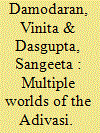

|
|
|
|
|
| Summary/Abstract |
On 6 December 1959, the image of Indian Prime Minister Jawaharlal Nehru inaugurating the Damodar Valley Corporation dam project in Bihar with a 15-year-old Adivasi girl called Budhini Manjhiyan was flashed across the national newspapers. This was an iconic moment in the national debate around development and change which was to dominate modern India on whether lands, predominately rural and tribal, were to be flooded to benefit the nation. Years later, in 2016, when the newspapers caught up with Budhini, she had returned to Jharkhand and was struggling to make ends meet for herself and her children. Her story resonates with the ways in which, in recent times, Adivasis are becoming increasingly visible as subjects in debates around indigeneity, identity, conversion, development, and climate change. The post-colonial Indian state and its allies, with a developmentalist agenda uppermost in their minds, have made loss of land, displacement, migration, and forced resettlement a part of Adivasi experiences. Forces of globalization, often in tandem with the policies of the Indian state, are engulfing marginal spaces. The increasingly powerful majoritarian narrative of the state subsumes alternate voices with easy nonchalance. The foregrounding of planetary narratives on the fate of humanity in the era of the Anthropocene erases the importance of particular locales and specific communities that could offer an alternative to declensionist narratives. But amid this marginalization, there also lies a story of the assertion of Adivasi agency. Voices of Adivasis—although multiple and fractured—can be heard as they assert their identity, express their politics, and creatively negotiate with the state and its institutions. Scattered across India in geographically differentiated terrains, pursuing different occupations, and speaking different languages, the experiences of Adivasis are varied, as they inhabit many worlds. Their stories point to the multiplicity of cultures and myriad ways of thinking that must be accommodated within the ambit of the nation, and yet offer the possibilities of different ways of living and being on this earth.
|
|
|
|
|
|
|
|
|
|
|
|
|
|
|
|
| 9 |
ID:
187280
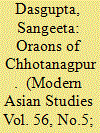

|
|
|
|
|
| Summary/Abstract |
This article explores nineteenth-century colonial representations of the Oraons of Chhotanagpur. Described in administrative reports of early nineteenth-century Chhotanagpur as mlecchha and dhangar, or as part of a ‘village community’ of Coles/Kols, these Oraons, by the late nineteenth century, were referred to as a ‘tribe’. To trace the categories through which the Oraons journeyed across colonial records, I discuss texts and reports which later became part of bureaucratic memory. The shifts within official understanding, I argue, were related to the working of official minds, changing assumptions, and differing languages; the tensions within the discipline of anthropology and its application in the colony; the variations within ideologies of governance and the imperatives of rule; and interactions with ‘native’ informants and correspondents, along with personal observations of local practices. There remained, however, an uneasy tension between wider intellectual trends in Europe and their reverberations in the colony, and the experiences of governance: colonial knowledge was not always produced with arrogance and assurance but also with doses of uncertainty, hesitation, disquiet, and often despair. In the shifting representations of the tribe across the nineteenth century, there is, I suggest, a pattern. In the pre-1850s, local nomenclature was adopted and voices of dissent—expressed through agrarian protests in Chhotanagpur—were addressed. By the 1850s, the utilitarian agenda structured colonial imaginaries and interventions. The 1860s witnessed the interplay of ethnological concerns, missionary beliefs, and Arcadian principles. From the 1890s, the idea of tribe was overwhelmingly structured by the supremacy of disciplinary knowledge systems that increasingly supplanted the role of the ‘native’ informant.
|
|
|
|
|
|
|
|
|
|
|
|
|
|
|
|
| 10 |
ID:
187282
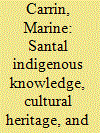

|
|
|
|
|
| Summary/Abstract |
Using different archives, I show how indigeneity was constructed by the Santal themselves during the second half of the nineteenth century, through various figures such as rebels and prophets. This has produced a Santal indigenous knowledge at the interface of orality and writing, revolving around two dimensions—an emergent historical consciousness and a feeling of shared identity, which still informs Adivasi resistance today, enabling them to voice assertion over natural resources. The sacralization of the landscape through pilgrimages and ritual commemorations entails the liberation of formerly encompassed identities, allowing the subaltern communities a certain visibility in the public sphere. Providing a new imagining against dispossession and memory loss, indigenous knowledge, which combines multi-scripturality and ritual innovations, becomes a resource for politics of representation as well as of a common Santal identity.
|
|
|
|
|
|
|
|
|
|
|
|
|
|
|
|
| 11 |
ID:
187290
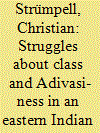

|
|
|
|
|
| Summary/Abstract |
In the eastern Indian steel town of Rourkela, Adivasis are widely stereotyped as uneducated, jangli (‘wild’), and drinkers, and they are therefore held to make for a special type of worker. Their Adivasi ‘nature’ makes them an ideal fit for facing the heat, dust, and fumes in the so-called ‘hot shops’ of the local public-sector steel plant. It is also said that Adivasis are, in fact, not well suited for the permanent and well-paid jobs the public-sector steel plant provides, and that they are better employed as contract workers who are paid little and by the day, and on whom the industry has increasingly relied since the 1970s. Critically engaging with Bourgois’ concept of ‘conjugated oppression’, I will show how these casteist stereotypes entrench the class position of Adivasis in the local steel industry, but also how this position has nevertheless changed over time—for some for the better, for many for the worse. Furthermore, although this polarization is driven by larger political economic changes it is exacerbated by the ways in which the better-off among the stereotyped Adivasi workers respond to them. This calls, I argue, for close attention to be given to the historical dynamics in the relations between class and caste (or ‘tribe’) and in the struggles related to them.
|
|
|
|
|
|
|
|
|
|
|
|
|
|
|
|
| 12 |
ID:
187289
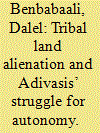

|
|
|
|
|
| Summary/Abstract |
Based on a case study of the Bhadrachalam Scheduled Area of Telangana, this article argues that the Adivasis of Central India seek autonomy as a response to their dispossession and to the accumulation of capital taking place in their resource-rich territories. The two main factors that have curtailed Adivasi autonomy through land alienation are analysed. The first is a process of agricultural colonization, wherein settlers belonging to agrarian dominant castes have moved into Adivasi territory and acquired tribal lands, thus dispossessing the original owners and reducing them to daily wage labourers. The second process is the industrialization of tribal areas where raw material is available and manpower is cheap, allowing for rapid accumulation through the exploitation of both nature and labour. Adivasis’ struggle for autonomy is therefore a way to reclaim control over their own resources and to preserve their distinct identity.
|
|
|
|
|
|
|
|
|
|
|
|
|
|
|
|
|
|
|
|
|